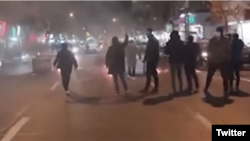Welcome back to The Farda Briefing, an RFE/RL newsletter that tracks the key issues in Iran and explains why they matter. To subscribe, click here.
I'm Frud Bezhan, regional desk editor for Iran, Afghanistan, and Pakistan. Here's what I've been following and what I'm watching out for in the days ahead.
The Big Issue
Fewer Iranians have protested on the streets in recent days, more than three months after the nationwide antiestablishment demonstrations erupted.
From the outset, the authorities responded to the rallies with lethal force and mass arrests. But in recent weeks, the government has used increasingly brutal tactics, including the public execution of protesters, in a bid to curb the rallies.
But that has not stopped some Iranians from risking their lives and taking to the streets, especially in the western Kurdistan region, which has been the epicenter of the demonstrations. Three days of protests and strikes were held on December 19-21, following a call for action by protesters.
More Iranians have moved their protests to their rooftops and windows as the risk of arrest and physical harm has increased on the tightly controlled streets.
Videos widely shared on social media appear to show protesters shouting from rooftops and windows late into the night in major Iranian cities in recent weeks. The practice is not new but has become more widespread recently.
Why It Matters: During the protests, Iranians have found new and creative ways to continue the demonstrations. Besides resorting to shouting antiestablishment slogans at night from their rooftops and windows, some protesters have turned to protest art and graffiti.
While less dangerous, those protesting from their homes are not completely safe. Security forces have shot at and broken the windows of apartment buildings where residents have chanted antiestablishment slogans. Security personnel have also damaged cars parked outside these residential buildings.
What's Next: These acts of dissent are likely to continue and increase as the government clampdown intensifies. They are difficult for the authorities to stop and allow protesters to sustain the demonstrations with fewer risks.
Stories You Might Have Missed
• An Iranian political activist imprisoned in the western city of Bukan and subsequently transferred to hospital after falling into a coma died on December 18.
Hengaw, a Norway-based group that monitors rights violations in Iran's Kurdish regions, said Mohammad Haji Rasoulpour was arrested in October during antiestablishment protests in Bukan.
After being rearrested in November, Rasoulpour fell into a coma and later died due to severe injuries he suffered as a result of being tortured, his family said.
• Activis 15-year-old Iranian teenager imprisoned in the central city of Karaj was released on December 15 after an interview with his mother went viral on social media.
Amirhossein Rahimi’s mother told the Tehran-based Etemad newspaper that her son has been in prison for two months even though he still had pellets in his head and chest from wounds inflicted by security forces shooting at crowds during an antiestablishment protest.
She told Etemad that the judge would not reduce bail to an amount she could afford. Following the interview, the teenager was released from detention on a reduced bail.
What We're Watching
Iran's national currency, the rial, has fallen to record lows against the U.S. dollar in recent days. The rial traded at 396,700 to the dollar on December 20, according to traders in Tehran and the Bonbast.com foreign-exchange website.
The antiestablishment protests have worsened the already bleak economic situation in Iran, where the economy has been crippled by years of U.S. sanctions and government mismanagement. During the protests, businesses and state employees have staged dayslong strikes that have hit the economy.
The rial has lost nearly 20 percent of its value since the protests erupted in mid-September.
Why It Matters: The plunging value of the rial will add more pressure on the authorities in Iran, where protests over economic grievances preceded the latest nationwide demonstrations.
The rallies have yet to bring large parts of the economy to a halt. But if the protests continue and larger and more regular strikes by public employees are held, observers say there could be significant consequences for the clerical regime.
That's all from me for now. Don't forget to send me any questions, comments, or tips that you have.
Until next time,
Frud Bezhan
If you enjoyed this briefing and don't want to miss the next edition, subscribe here. It will be sent to your inbox every Wednesday.







